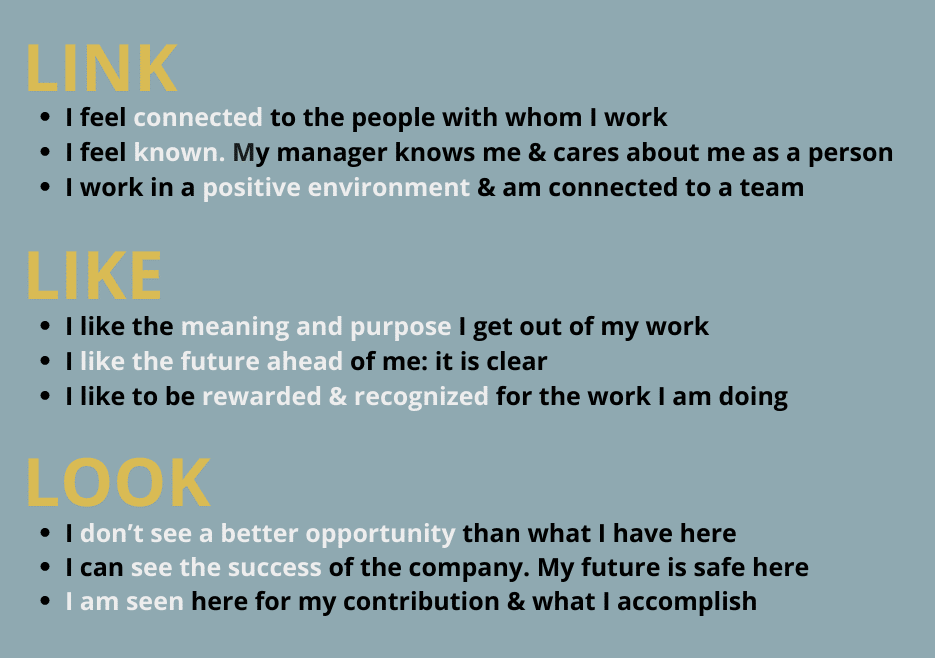We’ve all heard bad boss stories, but this one will tug at your heartstrings.
My friend’s father worked in a job he loved as a civil engineer in North Carolina. Years after retirement he was diagnosed with Alzheimer’s. During his decline he kept re-living a short two-year time in his career where he had a terrible manager. Sadly, the PTSD of the terrible manager stood out in his mind during the dementia and he experienced this time over and over. Nothing the family could say or do could pull him out of the traumatic memories during this one season of life. I think about this story often because it’s at the core what Darcy and I do: we coach people to create environments and provide leadership that allow people to find joy in their work – so work brings meaning and purpose to life.
One of the most exciting opportunities we see is development of the “next level” leader.
We continue to see this generation is self-aware and wants to work for leaders who care. Team members want to produce successful work output, and they want to be treated as a “whole-person.” All of us can be wonderfully stretched to learn to lead in a new “kind leadership” approach.
So, what can we learn as leaders right now? What should we be doing in a new way?
Become the Chief Energy Officer.

Every communication is about a transfer of energy. Momentum & energy start with you.
As a leader, you are setting the pace for your team’s energy and excitement. If you can bring a level of positive energy you’ll have an easier time connecting with other people. Have you seen the video where a man ignites a chain reaction of laughter on a crowded commuter train? He starts to laugh and just keeps laughing harder and louder. Soon enough, fellow passengers’ smiles get bigger and eventually turn to laughter as well.
Walk by a stranger and smile and you’ll see their instinct is to smile back. Think about what energy you’re bringing and remember how contagious that is. Your brain doesn’t know whether a smile is real or if a laugh is real – it just knows you told it to be in a good mood so it responds by releasing happy chemicals.
Link, Like and Look.
Here’s a quick method to remember why people work: Link, Like, and Look.
LINK – I’m connected. Recently I was meeting with a team in a tough, growing business. They were tired and exhausted. So, I asked them: What is the vision of working together like? Why would you stay here here versus going somewhere else? What unique thing you would say about why you’re looking forward to the future? They simply responded, “We just like one another.” Yes, work is stressful for them, but they like working together. I don’t think there’s a risk of anyone resigning because they get along so well. They’re “linked” together.
LIKE is how I feel in my connection with human beings. I am reminded of a story about someone observing a worker loading cans into a Coke machine. The worker was so happy and whistling the observer asked him, “Don’t you get tired of your  job?” He replied, “Not at all. Every time I put a can in this machine, I say a prayer for the person who will receive it. I pray they will really enjoy it and it uplifts their day.” It is this mental space we put ourselves into and frame how we look at things. People want to know what their future is. They want to know they will be rewarded and recognized for the work they do.
job?” He replied, “Not at all. Every time I put a can in this machine, I say a prayer for the person who will receive it. I pray they will really enjoy it and it uplifts their day.” It is this mental space we put ourselves into and frame how we look at things. People want to know what their future is. They want to know they will be rewarded and recognized for the work they do.
LOOK – remember that people are always looking around for at other opportunities. Instead of finding a better company, allow employees to see the success of your team. People want to be seen for their contribution, so remember how they’re looking at their role and value might be different than how you’re seeing it. Also, be sure to give good and steady feedback to make them feel valued.
To sum it up: Are my people linked to one another? Do they like what they’re doing? And, when they look around, do we look better than anyone else?
The new non-negotiable is self-awareness.
These days, everybody has a little PTSD from COVID, and the new “work from anywhere.” We’re all a little bedraggled with staffing shortages and supply chain issues. But, if you don’t know yourself and how you’re going to respond under stress, you’re going to have a hard time. This is one of the core things we teach because there are easy ways to understand how people work and then see yourself in context to all people. Leaders who think they can “act” like they care about their people and still get the best out of people will ultimately find themselves without people.
- Self awareness: know yourself and how you respond under stress
- Understand others: learn the basics of how people operate
- Emotional Intelligence: learn to broaden your perspective and be open minded
- Look up and look around: today’s leader must be able to zoom in to the work needed and then easily zoom out to the big picture
- Be Visible: connect with people, cast vision, know team members’ names
- Data-based decisions: follow critical thinking techniques and teach others to make values-based decisions.
- Cultivate trust: be humble, resilient and honest and transparent.
How do you, as a leader, rate yourself in these areas?

